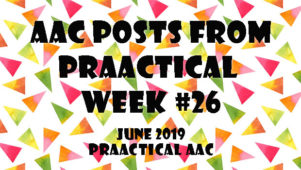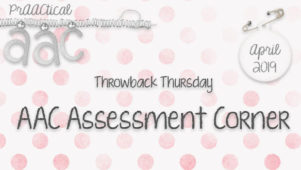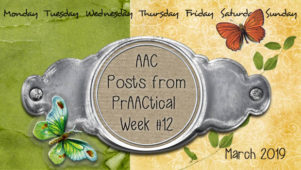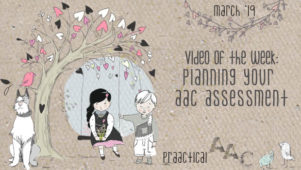5 Tips to Make AAC Assessments Run Smoothly
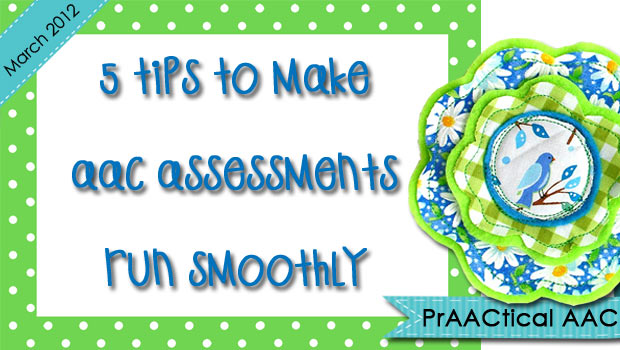
No one likes to be tested, least of all people with communication difficulties who don’t have the tools to express their anxiety or discomfort in the ways they would like to. Some of the people we evaluated had real issues with this and so we’ve experimented with ways to make the testing less stressful and more productive. Here are some of the strategies that we found to be most successful.
–
1. Work with the team to establish Fair Testing Practices for the person you’ll be evaluating. Our chapter on ‘Language Assessment for Students Who Use AAC’ describes this in more detail, but essentially it involves writing a ‘rule book’ for how to test this person. It might specify how long the test session can/should be, how to set up the situation so the person can respond, and what other supports are needed so that we are testing the person’s knowledge and skills and not things like their stamina or coping skills. It was written with Lisa Proctor and is in the book Practically Speaking Language, Literacy, and Academic Development for Students with AAC Needs.
–
2. Social Narratives: We all use them to help people know what to expect and do in social situations, but I had never used them to help a child prepare for an evaluation until I was asked to evaluate Tommy. Tommy came to our clinic for therapy with Robin and a graduate student, and there was concern that when he came to see me for an evaluation, he would be upset by the violation of the ‘speech clinic’ routine. To prepare him for that change, we developed a social story, which you can see here. Tommy’s mom read it with him for each of the 5 nights preceding the evaluation. He responded amazingly well – no problems whatsoever. From that point forward, we began to use them prior to AAC evaluations for a range of people. The social story tells about about what will happen during the assessment, and gives some reassurance that it is okay not to know all the answers, okay to ask for help, and oka/assessment_schedule.png) y to ask for a break. Advance information about the testing activities and preparation for some coping strategies that can be used is a winning combination.
y to ask for a break. Advance information about the testing activities and preparation for some coping strategies that can be used is a winning combination.
–
3. Visual Schedules: The other really successful strategy we’ve used is a visual schedule that shows the events in the session. If the person you’re testing is already using some form of visual schedule at school or in therapy, do your best to emulate those (e.g., use the same type of symbols). Have one symbol for each activity in the evaluation, including breaks and a final one for leaving. It can be hard to depict between different formal tests, so we came up with a creative way to make the distinctions clearly visible. We choose some arbitrary symbols (e.g., sun, tree, flower) and use those to label the different test materials. For example, the PPVT may become the ‘Apple Book’ and the ROWPVT might become the ‘Flower Game.’ You can put large symbols on front of the test booklet or put the test materials into a bag or bin with the symbol on it. The schedule then has the symbols in the order that you would do them in the session. I generally start with whatever is going to be easiest, then go to something more challenging, then alternate between easy and difficult for the remainder of the sessions. Don’t forget about breaks-those go on the schedule, too.
–
4. Breaks: Planned breaks are wonderful and give everyone a chance to recharge their batteries. Try inserting a few small breaks when the learner can relax and enjoy some music, look through a book, or interact with a favorite toy. In addition, giving the learner a quick and easy way to ask for a break during the testing session can stave off negative behaviors. We like to use a Big Mack or visual support that is large and easy to use.
–
5. Reinforcement: The final strategy is to have some super special reinforcement that the learner will have access to during breaks in the test session and/or at the end for good effort. We’ve seen some clinicians use a token reinforcement system so that the person earns tokens for good effort that can be redeemed for something special.
–
Testing is never fun, but adequate preparation and attention to the use of visual strategies can ease the learner’s anxiety, promote a positive attitude, and make for a smoother session.
–
Filed under: PrAACtical Thinking
Tagged With: assessment, social stories, visual schedule
This post was written by Carole Zangari

